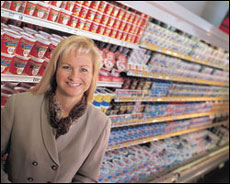
With a little more than 13% of the U.S. population (about 38.6 million Americans) being of Hispanic descent, it would be foolish to ignore this powerhouse consumer demographic when formulating and marketing dairy foods. Amazingly, Hispanics account for more than half of the total population growth in the United States.
It is important to note that Hispanic market growth is skewing young. In fact, about two-thirds of all U.S. Hispanics are under the age of 34, whereas only 44% of the general market is less than 34 years old. U.S. Census 2000 shows that 70% of all U.S. Hispanics reside in six states-California (31.1%), Texas (18.9%), New York and New Jersey (11.3%), Florida (7.6%) and Illinois (4.3%). The remaining 26.8% of U.S. Hispanics are spread across the country, with several cities in the northwest and southeast becoming hot spots. This is crucial information for marketers.

This supports the introduction of numerous milk and dairy-based beverages that have Hispanic flair. For example, Rosa's Original, LLC, Glenview, Ill., markets Rosa's Original Horchata. This traditional Mexican beverage is made with water, milk, rice and flavorings. The line started out with a traditional cinnamon flavor, and soon included melon and strawberry varieties. Rosa's Horchatas are the first, and so far the only horchatas to be sold in shelf-stable, single-serve (15-oz) glass bottles.
Kefir-leader Lifeway Foods Inc., Morton Grove, Ill., expanded beyond its Russian roots with LaFruta drinkable yogurt. This single-serve (8-oz) refrigerated plastic bottle line is particularly attractive to Hispanics because of the beverages' sweet flavor profiles and bright colors. Recently the company rolled out two authentic Hispanic LaFruta flavors: Horchata and Tres Leche.
World-renowned chef Wolfgang Puck is also appealing to Hispanic consumers with the dulce de leche flavor in his new four-variety line of coffee-milk drinks. Made with low-fat milk, shelf-stable Wolfgang Puck Gourmet Lattes are packaged in 11-oz glass bottles. Rich espresso, rich mocha and French vanilla join dulce de leche. All varieties are sold as either individual units or in four packs.
Hispanic flavors work well in many types of foods. It just so happens that the dairy industry also has the franchise on another food group popular among Hispanics-ice cream and frozen novelties. Manufacturers across the country are formulating frozen desserts with names like Tres Leche con Fresca, Ensalada de Fruta and TrioTropical.
If you have any doubts when contemplating the addition of a "Hispanic" flavor or two to your product lines, think back to the days when salsa first went mainstream. Now, think about where salsa is today.



